Customer Company Size
Large Corporate
Region
- America
Country
- United States
Product
- nGenius solution
- InfiniStream appliances
- nGenius Integrated Agent for Cisco ISR
Tech Stack
- Cisco 3825 ISR
- Cisco Application eXtension Platform
- NME service modules
Implementation Scale
- Enterprise-wide Deployment
Impact Metrics
- Customer Satisfaction
- Productivity Improvements
Technology Category
- Networks & Connectivity - Network Management & Analysis Software
Applicable Functions
- Business Operation
Use Cases
- Remote Asset Management
- Predictive Maintenance
Services
- System Integration
About The Customer
EMC Insurance Companies is one of the 60 largest property and casualty insurance companies in the United States and has been serving policyholders and independent insurance agents for 100 years. Headquartered in Des Moines, Iowa, EMC employs more than 2,100 employees and has assets exceeding $3 billion. EMC sells its products solely through independent insurance agencies in more than 40 states. The company believes that a tight partnership with its agents is essential to delivering a superior level of personalized service to its policyholders. A strength that sets EMC apart from other insurance companies is their decentralized operating structure that enables them to provide localized service from their 16 regional branch offices and five regional service centers. This unique office structure positions EMC employees in close proximity to its policyholders and agents, enabling its representatives to fine-tune strategies, products and pricing to meet the needs of individual territories and agents with tailored underwriting, marketing, claims, and loss control services.
The Challenge
EMC Insurance Companies was looking for a scalable solution to extend network visibility from the main campus and two data centers to 16 branch offices and five service centers in a cost- and resource-effective manner. They needed to assure high-quality service performance and optimal responsiveness to end users while keeping pace with new service roll outs and new technologies. The company’s core networked business services include insurance policy transaction processing, claims processing, image processing, email, Voice over IP (VoIP), video conferencing and Internet. Most of the claims and transaction processing applications are programmed in-house using Unisys’ Business Information Server (BIS) programming language and database. These business-critical applications run primarily on two Unisys mainframes where the bulk of EMC’s business-critical information is processed and stored. Web servers provide the front- end interface between the independent agents and policyholders, and the mainframes.
The Solution
EMC became a NetScout customer in 2009, initially deploying the nGenius solution with two InfiniStream appliances which fed into an nGenius analysis console to help better identify reasons for network slowdowns at remote sites. Since their initial implementation, EMC has leveraged additional value and uses for the nGenius solution. In addition to response time analysis, the nGenius solution also helps them to identify emerging performance issues, expedite problem resolution, and better optimize their delivery of critical services. EMC experienced an unexpected increase in complaints from branch office employees about the responsiveness of a new application. The IT operations team is challenged in identifying the source of performance issues and cannot pinpoint the exact cause of degradations being experienced by end users. They need to determine if the issue is being caused by the WAN, the application, or the servers. In order to gain better visibility into application service delivery in the branch offices, EMC Insurance is deploying the nGenius Integrated Agent for Cisco® Integrated Services Router.
Operational Impact

Case Study missing?
Start adding your own!
Register with your work email and create a new case study profile for your business.
Related Case Studies.

Case Study
Remote Monitoring & Predictive Maintenance App for a Solar Energy System
The maintenance & tracking of various modules was an overhead for the customer due to the huge labor costs involved. Being an advanced solar solutions provider, they wanted to ensure early detection of issues and provide the best-in-class customer experience. Hence they wanted to automate the whole process.
.png)
Case Study
Improving Vending Machine Profitability with the Internet of Things (IoT)
The vending industry is undergoing a sea change, taking advantage of new technologies to go beyond just delivering snacks to creating a new retail location. Intelligent vending machines can be found in many public locations as well as company facilities, selling different types of goods and services, including even computer accessories, gold bars, tickets, and office supplies. With increasing sophistication, they may also provide time- and location-based data pertaining to sales, inventory, and customer preferences. But at the end of the day, vending machine operators know greater profitability is driven by higher sales and lower operating costs.

Case Study
Predictive Maintenance for Industrial Chillers
For global leaders in the industrial chiller manufacturing, reliability of the entire production process is of the utmost importance. Chillers are refrigeration systems that produce ice water to provide cooling for a process or industrial application. One of those leaders sought a way to respond to asset performance issues, even before they occur. The intelligence to guarantee maximum reliability of cooling devices is embedded (pre-alarming). A pre-alarming phase means that the cooling device still works, but symptoms may appear, telling manufacturers that a failure is likely to occur in the near future. Chillers who are not internet connected at that moment, provide little insight in this pre-alarming phase.

Case Study
Remote Wellhead Monitoring
Each wellhead was equipped with various sensors and meters that needed to be monitored and controlled from a central HMI, often miles away from the assets in the field. Redundant solar and wind generators were installed at each wellhead to support the electrical needs of the pumpstations, temperature meters, cameras, and cellular modules. In addition to asset management and remote control capabilities, data logging for remote surveillance and alarm notifications was a key demand from the customer. Terra Ferma’s solution needed to be power efficient, reliable, and capable of supporting high-bandwidth data-feeds. They needed a multi-link cellular connection to a central server that sustained reliable and redundant monitoring and control of flow meters, temperature sensors, power supply, and event-logging; including video and image files. This open-standard network needed to interface with the existing SCADA and proprietary network management software.









